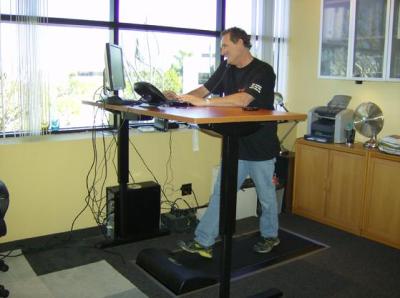Just because you have a desk job doesn’t mean you need to watch your waistline grow year after year.
If you can walk, you can use a treadmill desk. It’s a surefire way to burn extra calories and feel healthier while you get your work done.
For two years, I stood while I worked. I left the desk chair behind because I feared the negative health effects of sitting at my desk for eight or more hours each day. After all that standing, though, I was ready to take the next step- iterally.
Related stories
How to deal with work-related stress before it destroys you
Be kind, unwind – How IT pros can truly enjoy that much needed vacation

I now walk between eight and nine miles while I work, burning thousands of calories in the process. Here’s how you can do it, too:
Start saving
My single biggest delay in upgrading to the treadmill desk wasn’t fear of walking that much or losing my balance; rather, it was the significant financial investment involved. I already had a desk at standing height, so I completed my setup with the TreadDesk, which set me back $800. (The TreadDesk includes a slim treadmill that fits under a desk and detachable controls.)
If you already have a treadmill and just need a desk, you will likely find that your treadmill’s handlebars get in the way. Consider options like the $479 TrekDesk Treadmill Desk if they’ll fit your setup.
If you need both a stationary or adjustable-height standing desk and a treadmill, prepare to spend north of $2,000 to get up and running (or walking). Some companies, such as Steelcase, sell the complete package–treadmill and desk. Other companies to check out include Signature.
Try standing first
I wouldn’t advise anyone go from a sitting setup straight to a walking setup. Before you shell out the money for any serious equipment, I think it’s wise to spend some time standing first. That way you’ll get accustomed to leaving the chair behind and typing in a standing position.
To create my original makeshift standing desk, I used a regular-height desk with Ikea shelf-toppers and small tables atop it. It’s important to get your screen(s) at eye level, and your keyboard and mouse at a comfortable height. Standing will initially feel odd. But you’ll quickly learn important tricks like wearing good shoes and socks and taking occasional sitting breaks.
Make space
After you’ve grown accustom to standing, you’ll be ready to make the leap to the treadmill. Mine is just shy of 5 feet long, which meant I had to clear out some room in my home office. You’ll obviously need a flat surface to place the tread upon. If your workspace is carpeted, make sure that the tread you’re looking to buy works on such a surface; if it doesn’t, you may need a treadmill mat to place underneath the tread itself.
Make your choice
If you’re handy with power tools, you may be able to build a desk, buy a used treadmill, and save yourself serious money. Sites like Ikea Hacker, eHow, and others have detailed instructions for homegrown solutions.
If you order a ready-made solution, you needn’t fear much setup effort; treadmills for desks typically ship pre-assembled. You just plug them in and start walking.

Keep in mind that treadmills built for desk use will have key features that a home-built solution will lack. Chief among those is detached controls. With my TreadDesk setup, the control panel (for adjusting speed, starting and stopping the tread, and tracking my statistics) sits on my desk surface, adjacent my keyboard. If your home setup obstructs your treadmill’s buttons or display, it could quickly become frustrating. You need to stop the treadmill numerous times each day–when the doorbell rings, or nature calls, or hunger strikes–and fumbling for the controls to shut the tread off (or get it started again) is a no-go. Make sure the buttons are always within easy reach.
Get ready to re-learn multitasking
To start with, you will want to set your walking speed no faster than one mile per hour. Seems slow, right? But don’t forget that you could be walking for your entire workday, so you’re getting ready for a marathon, not a sprint. Even more importantly, of course, you’re not just walking for all those hours at a time–you’re working, too! At one mile per hour, it’s still pretty easy to type and conduct phone calls at the same time. If you double that speed, your typing will likely suffer.
If you peg your speed at one mile per hour and walk four hours per day while you work, you’ll cross your hundredth mile in just five weeks. I’m now walking around 1.1 or 1.2 miles per hour for eight hours a day. It’s not just hundreds of miles–it’s thousands of burned calories, too. Each 3,500 surplus calories you burn is equivalent to about one pound, so you might want to start saving up cash for some new pants, too!
Frequent Macworld contributor Lex Friedman wrote this entire article at 1.2 miles per hour.




